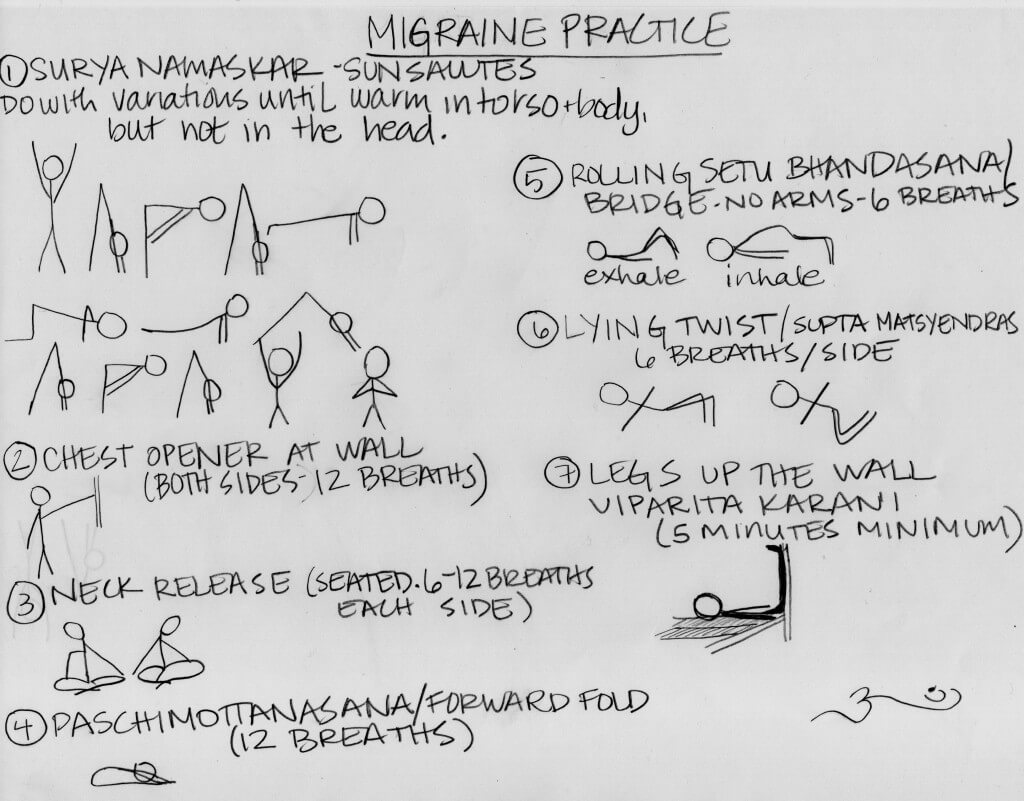Approximately 28 million people in the U.S. alone suffer from migraines. Migraine symptoms include an intense throbbing headache (often in one spot in the head) and possibly nausea and vomiting. Migraines can last for hours or days making them debilitating for many sufferers. There is debate as to what causes these headaches. Common ideas are blood sugar, hormonal changes, food triggers, and muscle tension.
When a migraine is acute, yoga therapy doesn’t have much to offer. The most common remedy is to be in a dark, quiet space and possibly take painkillers. However, yoga therapy can be a very helpful paradigm as a preventative measure. One way yoga might help with migraines is to release tension in the muscles that contribute to neck and head tension. Releasing the muscles of the chest, upper back, and neck can reduce migraine frequency in some people. Where yoga therapy really shines though, is regulating the pranic system and specifically the pitta dosha. When pitta is regulated, migraines can be decreased.
Pitta in Ayurveda is associated with the fire element and finds it’s home in the belly area. When we are balanced that powerful energy circulates around the body and then finds it’s home in the belly. When imbalanced, this process doesn’t go so smoothly and health issues can be created. In this case, we can think of it as the pitta getting stuck in the head and causing migraines. (If this description doesn’t work for your brain think of it as a simple metaphor for the thousands of biological processes that are occurring).
In a person where pitta tends to go out of balance, the trick to healing is consistent maintenance. This could be done with various yogic techniques which include movement (asana), breath work (pranayama), and meditation.
I’d like to look at how to balance Pitta with movement practice. (As shown in this practice)  The idea here is to catch up with that out of control pitta fire. To do this we have to work harder at first by doing sun salutes until we are warm in the entire torso but not in the head. In this way, we become more sensitive to our internal fire being able to tell the difference or stop before it goes to the head. Once we are sensitive to it we can slow down and allow the pitta to circulate properly. We then slow down with some poses that release back and neck tension, finally ending up in an inversion (legs up the wall) completely relaxed and balanced. In this way, we teach our system how to use pitta properly and we become more regulated. This leads to reduced pitta deregulation and fewer migraines.
The idea here is to catch up with that out of control pitta fire. To do this we have to work harder at first by doing sun salutes until we are warm in the entire torso but not in the head. In this way, we become more sensitive to our internal fire being able to tell the difference or stop before it goes to the head. Once we are sensitive to it we can slow down and allow the pitta to circulate properly. We then slow down with some poses that release back and neck tension, finally ending up in an inversion (legs up the wall) completely relaxed and balanced. In this way, we teach our system how to use pitta properly and we become more regulated. This leads to reduced pitta deregulation and fewer migraines.
I’ve used this approach with clients and it has helped them tremendously. The most dramatic example was a young lawyer who went from being hospitalized for a 30-day migraine to using these ideas and being migraine free within months. I offer this example, not as a guarantee, but to give hope to those suffering, an alternative approach to their migraines that may bring much-needed relief.
Blessings – May we all be free of suffering!
Brandt
Interested in yoga therapy certification and helping others as a therapist? Check out our upcoming classes to apply.
Brandt talks about common questions applicants have about the Breathing Deeply Yoga Therapy Program. Tune in to get the full program details.
Friends in Yoga, The way we perceive the world is a curious thing. Is it on fire or getting better? Are we facing our challenges or shying away from them? Are we functioning from the present or some altered reality based on past experiences? The teachings tell us that reality is ultimately timeless. The vibration […]
There’s no doubt that yoga is gaining popularity, but you may be asking yourself, what is the most popular type of yoga? Where is each type most popular in the U.S. and around the world? And for those who are interested in trying it themselves, how can you practice these styles of yoga safely? For […]
Friends in Yoga, Sitting on a cushion, taking a yoga class, chanting a mantra before your morning coffee…no one would call these radical acts. They are small choices that we make to better ourselves. The motivation to practice often takes form by our desire to be healthier, to be more focused, to connect with our […]